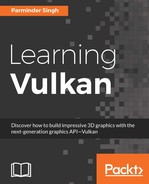- Learning Vulkan
- Learning Vulkan
- Credits
- About the Author
- Acknowledgments
- About the Reviewer
- www.PacktPub.com
- Preface
- 1. Getting Started with the NextGen 3D Graphics API
- 2. Your First Vulkan Pseudo Program
- Installing Vulkan
- The Hello World!!! pseudocode
- Initialization - a handshake with the device
- Swapchain initialization - querying the WSI extension
- Supplying shaders - shader compilation into SPIR-V
- Building layouts - descriptor and pipeline layouts
- Creating a Render Pass - defining a pass attribute
- Framebuffer - connect drawing images to the Render Pass
- Populating geometry - storing a vertex into GPU memory
- Pipeline state management - creating pipelines
- Executing the Render Pass - drawing Hello World!!!
- Queue submission and synchronization - sending jobs
- Displaying with presentation layer - rendering a triangle
- Fitting it all together
- Summary
- 3. Shaking Hands with the Device
- 4. Debugging in Vulkan
- 5. Command Buffer and Memory Management in Vulkan
- 6. Allocating Image Resources and Building a Swapchain with WSI
- Getting started with image resources
- Understanding image resources
- Memory allocation and binding image resources
- Introducing swapchains
- Understanding the swapchain implementation flow
- The swapchain implementation's class block diagram
- Renderer - a window management custom class
- VulkanSwapChain - the swapchain manager
- Creating the surface with WSI and associating it with the created window
- The graphics queue with present support
- Querying swapchain image formats
- Creating the swapchain
- Creating a depth image
- Summarizing the application flow
- Summary
- 7. Buffer Resource, Render Pass, Framebuffer, and Shaders with SPIR-V
- 8. Pipelines and Pipeline State Management
- Getting started with pipelines
- Caching pipeline objects with a PCO
- Creating a graphics pipeline
- Understanding compute pipelines
- Pipeline State Objects (PSO) in Vulkan
- Implementing the pipeline
- Summary
- 9. Drawing Objects
- Overview of the drawing process in Vulkan
- Preparing the drawing object
- Rendering the drawing object
- Rendering an indexed geometry
- Understanding synchronization primitives in Vulkan
- Resizing the display window
- Summary
- 10. Descriptors and Push Constant
- 11. Drawing Textures
- Image resource - a quick recap
- Prerequisites for texture drawing
- Implementing the image resource with linear tiling
- Implementing the image resource with optimal tiling
- Loading the image file
- Buffer object memory allocation and binding
- Populating the allocated device memory
- Creating the image object
- Image object memory allocation and binding
- Creating a command buffer object
- Setting the image layout
- Buffer to image copy
- Setting the optimal image layout
- Submitting the command buffer
- Creating an image sampler
- Creating the image view
- Copying data content between images and buffers
- Updating the descriptor set
- Summary
This section provides a short description of the working of our first Vulkan pseudo application. The following diagram is a snapshot of the working model:

First, the application creates the Vulkan instance and device at the initialization stage with the necessary layers enabled and extensions created. The device exposes various queues (graphics or compute) as shown in the preceding diagram. These queues gather the command buffers and submit them to the physical device for processing.
Using the WSI extension, drawing surfaces are prepared for rendering graphic contents. The swapchain exposes these drawing surface as images, which are used in the form of image views. Similarly, the depth image view is prepared. These image view objects are used by the framebuffer. Render Pass makes use of this framebuffer to define a unit-rendering operation.
The command buffer is allocated from command buffer pools, and it is used to record various commands along with the Render Pass execution process. The Render Pass execution requires some vital Vulkan objects, such as the graphics pipeline, the descriptor set, shader modules, pipeline objects, and geometry data, as shown in the preceding diagram.
Finally, the command buffer is submitted to a presentation-supported (plus graphics) queue. Once submitted, it is processed by the GPU in an asynchronous fashion. Various synchronization mechanisms and memory barriers may be required to make the rendering output hitch-free.
-
No Comment
